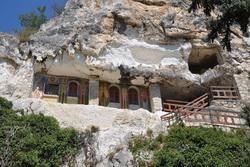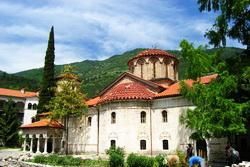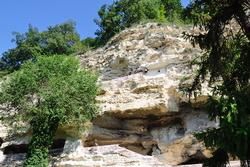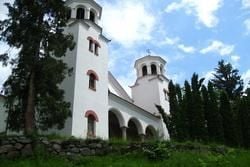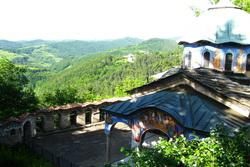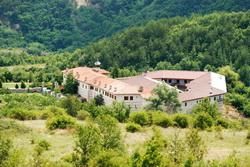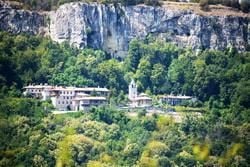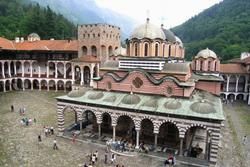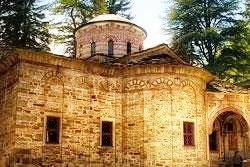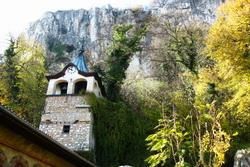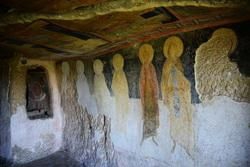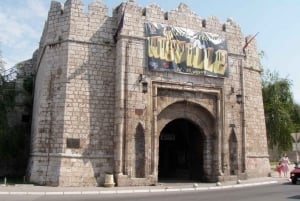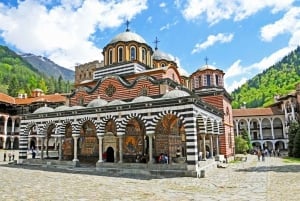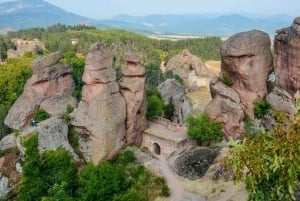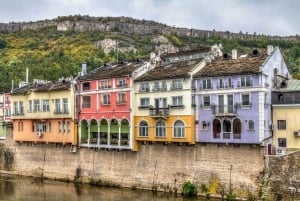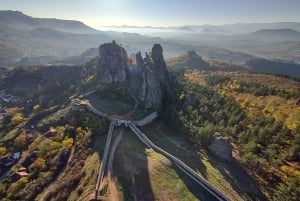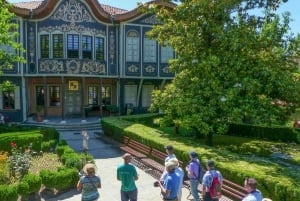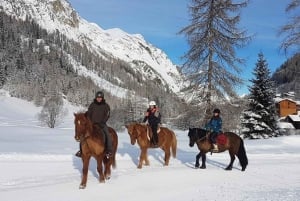Monasteries in Bulgaria
Rila Monastery (The Monastery of St. Ivan of Rila):
The Rila Monastery is the biggest monastery in the country. The Rila Monastery is located approximately 100 km south of
Sofia, the capital city, and just a couple of kilometres away from
Borovets, the oldest ski resort in Bulgaria.It lies hidden amid the thick deciduous forests of
Rila Mountain at about 1147 m above mean sea level. Read more
here...
Bachkovo Monastery:
It is located some 30 km south of
Plovdiv and happens to be the second biggest monastery in Bulgaria. It was founded in 1083 by Georgian brothers Grigorii and Abasii Bakuriani who managed to gain autonomy for the holy place from the Byzantine emperor. The charnel-house, erected at the very founding of the monastery, is also the oldest building on its territory. The rest of the complex was constructed some time later in the 17th century. St. Nicholas Church, situated in the southern yard of the complex, is where the most significant wall paintings are kept. Their importance comes from the fact that they are the first certified work of Zahari Zograf, the greatest Bulgarian artist of the 19th century.
Pamporovo, the biggest ski resort in the
Rhodope Mountains, and
Asen’s Fortress, a medieval Bulgarian stronghold, are both located in close proximity to Bachkovo Monastery.
Aladzha Monastery:
This 700-year-old rock-hewn monastery is located in the eastern part of the country, not very far from
Varna, the biggest city on the Bulgarian
Black Sea Coast, and Golden Sands, one of the most popular national sea resorts. Its unusual design includes two levels dug directly into some steep limestone rocks that offer a wonderful view of the blue sea. You can combine your visit to the monastery with a walk along the shady woods of
Golden Sands. There you will find plenty of wooden benches and fountains, which invite you to sit down and have a picnic.
Troyan Monastery:
The third biggest monastery in Bulgaria is located 10 km away from the beautiful town of Troyan in
Central Stara Planina (Old Mountain). Although the monastery was founded in the 16th century it wasn’t before the beginning of the 19th century that it became a truly remarkable architectural complex. Then the place underwent a huge reconstruction that turned out to be a great opportunity for some of Bulgaria’s best builders, artists and wood-carvers to reveal their impressive skills. And they all did, especially Zahari Zograf (if you fail to remember who he was, just skim through the paragraph about Bachkovo Monastery again) who decorated the main church of the complex with portraits of Bulgarian rulers, patrons and patriots. The monastery also holds a rich collection of icons, including a special icon of St. George and the miracle-working icon of the Three-Handed Holy Virgin, brought from Mt. Athos back in the 16th century, among others.
The Monastery of the Holy Transfiguration of God (Transfiguration Monastery):
The Transfiguration Monastery lies in a gorge on Yantra River 6km north of the historical town of
Veliko Tarnovo. It was founded in the 14th century and was pillaged and reduced to ashes on several occasions during the Ottoman Rule. The monastery’s active role in the spiritual flowering of Bulgarian people began with its reconstruction in 1920. In 1835 its main church was built. It was designed by master builders Dimitar Sofiyaliyata and Kolyu Ficheto. The murals and some of the icons are the work of … well, yes, you guessed correctly, Zahari Zograf again. A large number of the icons in the main church and the two smaller ones were painted by representatives of the famous Tryavna School of Painting. The seven-bell belfry is the most characteristic feature of the monastery complex. It was erected in the period 1858-1863 by Kolyu Ficheto, the most renowned Bulgarian civil engineer of all time. The Wheel of Life, a mural on the façade of the main building, is another landmark the Transfiguration Monastery is famous for.
Rozhen Monastery:
No one can tell for sure when exactly this holy complex was established but it is certainly among the most significant ones in the country. It is perched on top of a lofty hill in
Pirin Mountain near the town of
Sandanski, an attractive spa resort, and
Menik, the smallest town in Bulgaria. It has an unusual hexagonal design where the cells surround a neat little yard with a church in the middle. Just like the other monasteries, the Rozhen Monastery has a special miracle-working icon of its own, too. It depicts the Virgin Mary and is kept in St. Kozma and St. Damian Chapel. The monastery had its heyday in the 19th century when it was a religious and spiritual centre and owned many lands in the surrounding area.
The nearby village of
Rupite plays an important role in the spiritual life of Bulgarians as well. It is commonly regarded as a place governed by potent unworldly energies where miracles happen on a regular basis. No wonder that the renowned fortuneteller Vanga was born and lived there.
The Rock-Hewn Churches of Ivanovo:
The mosaic cells and churches carved into the cliffs above Rusenski Lom River are among the most important monuments of Bulgarian medieval art. They are located near the village of Ivanovo, 20km south of
Ruse. Only five cave sanctuaries have survived until present day but visitors will come across plenty of wall paintings there. The best preserved and the most valuable are the frescoes in the so-called "shrine church". It is hewn 32m above the river in a cave over the right bank. The compositions which date back to the period 12th – 14th century depict scenes from the life of Christ. The cave complex near Ivanovo was included in
UNESCO’s World Heritage List in 1979
The Monastery of St. Dimitar Basarabovski:
This rock monastery lies right next to the Rock-Hewn Churches of Ivanovo. More precisely put, it is situated in the valley of Rusenski Lom River, 10 km away from the city of
Ruse. According to some theories it was founded in the 12th century, however, the first historical records to mention it were written three centuries later. At the very foot of the rocks where the complex is built tourists will stumble across two chambers, a dining cave, and a staircase. It goes up to a platform where the church itself is located. Another flight of stairs leads to a different cave which plays the role of a tomb where the relics of Hrisant, the monk who renovated the monastery complex in 1937, are kept.
Klisura Monastery:
Ninety kilometres north of
Sofia, just off the road to the spa town of
Varshets, Klisura Monastery crouches beneath the pine-laden eastern slopes of Todorini Kukli Peak in Western
Stara Planina. Founded in 1240 and completely renovated in the 1990s, the monastery’s whitewashed buildings and lovely courtyard create the perfect atmosphere of rural peace. And this is the real attraction here, not the architecture, the frescoes or the historical significance of the place. Thanks to its location, the monastery is also often regarded as a good starting point for hikes around the mountain.
The Patriarchal Monastery of the Holy Trinity:
The monastery is situated in the gorge of Yantra River, near
Veliko Tarnovo. It was set up during the reign of Tsar Ivan Alexander (1331-1371) and is said to be one of the oldest religious complexes on the territory of the country. It is best known as the birth place of the Tarnovo Literary School, the medieval academy responsible for some of the most daring linguistic reforms and significant literary texts of the late 14th and early 15th centuries. Despite its immense appeal, however, today the monastery is closed for visitors. Those of you who still wish to get a glimpse at it from the outside must also keep in mind that the road leading there is pretty perilous and narrow so, in reality, the only way to reach it is by walking all the way up. And it is a kind of a long climb we must say (5 km give or take). But even this cannot strip the Holy Trinity Monastery off of its heavenly cloak.
Sokolski Monastery:
In 1833 Yosif Sokolski, a Bulgarian clergyman, set up a tiny church made of wood in a hilly area (now known as Balgarka Nature Park) on the northern slopes of
Central Stara Planina, some 15 km away from Gabrovo. Little did he know that this ramshackle building would grow out to become one of the most astounding churches on the territory of the country, boasting some impressive exterior and interior decorations, while its surroundings would transform into a beautiful monastery complex with a nice garden and delicate white stone fountain, made by master Kolyu Ficheto himself. At present, this is one of the extremely popular monasteries in the region and also the one that offers the most breathtaking views of the gorgeous mountain.


